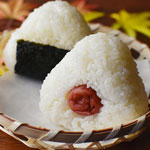National Rice Ball Day Date in the current year: April 19, 2026
 A lot of people think that National Rice Ball Day, which is observed annually on April 19, is dedicated exclusively to Japanese rice balls named onigiri. In reality, it celebrates a multitude of dishes from across the world that have two things in common: they are made from rice and shaped like a ball.
A lot of people think that National Rice Ball Day, which is observed annually on April 19, is dedicated exclusively to Japanese rice balls named onigiri. In reality, it celebrates a multitude of dishes from across the world that have two things in common: they are made from rice and shaped like a ball.Rice balls exist in many national cuisines, but they are particularly prevalent in Asia, where rice is a staple. Japanese onigiri is the quintessential rice ball, which is quite ironic because modern onigiri are typically triangular or cylindrical shaped.
The earliest recorded mention of Japanese rice balls dates back to the 11th century. Early onigiri were simply balls of salted rice without any filling or condiments. In the 18th century, when nori became widely available, it became customary to wrap onigiri in these dried seaweed sheets. Modern triangular onigiri became widespread in the 1980s thanks to the invention of the onigiri-making machine.
An onigiri usually consists of cooked white rice, some sort of filling, and nori, which helps to keep the onigiri together. Popular onigiri fillings include pickled plums (umeboshi), salted salmon, bonito flakes (katsuobushi), kelp (konbu), pollock roe (tarako), flying fish roe (tobiko), shrimp or tuna with mayonnaise, squid, braised pork, and more.
A Chinese take on rice balls is called zongzi. They are made of glutinous rice, which is mixed with soy sauce or white sugar (depending on whether the dish is intended to be sweet or savory), stuffed with various fillings, wrapped in bamboo or reed leaves, and steamed or boiled. The leaves are removed before eating.
Zongzi can be either sweet or savory. Common sweet fillings include red bean paste, mung beans, yam, lotus seed, and jujube. Popular savory fillings are chicken, pork, ham, red-cooked meat, Chinese sausage, mushrooms, hard boiled eggs, salted eggs, and dried scallops (conpoy). Fillings that can be used in both sweet and savory zongzi include chestnuts, various nuts, cooked peanuts, and vegetables.
Zongzi are known in many other Asian countries, where they may have different names. Variations of the dish can be found in Burmese, Cambodian, Indonesian, Japanese, Laotian, Mauritian, Philippine, Singaporean, Taiwanese, and Thai cuisines.
Indian rice balls are called pinda. They are made of cooked rice mixed with black sesame sees and ghee. Pindas are cooked for Hindu funeral rites; it is believed that they help recently departed souls to united with their ancestors.
While rice balls are particularly prevalent in Asia, they aren’t exclusive to Asian cuisines. For example, Italian cuisine has two kinds of rice balls: arancini and suppli. Arancini are a staple of Sicilian cuisine. They are stuffed with ragù (meat-based sauce) or cheese, breaded, and deep fried. Suppli are similar to arancini; they are made of risotto rice soaked with tomato sauce and stuffed with mozzarella. Elongated rice balls are coated in egg, breaded, and deep fried.
Some African cuisines have rice balls too. For example, omo tuo is a staple in Ghana. These rice balls are made with broken rice, which is cooked in a large amount of water and beaten to make it smooth. The sizable rice balls are usually served with soup.
- Category
- Unofficial Holidays
- Country
- USA
- Tags
- National Rice Ball Day, unofficial holidays, food days, rice balls, onigiri, zongzi, pinda, arancini, suppli, omo tuo